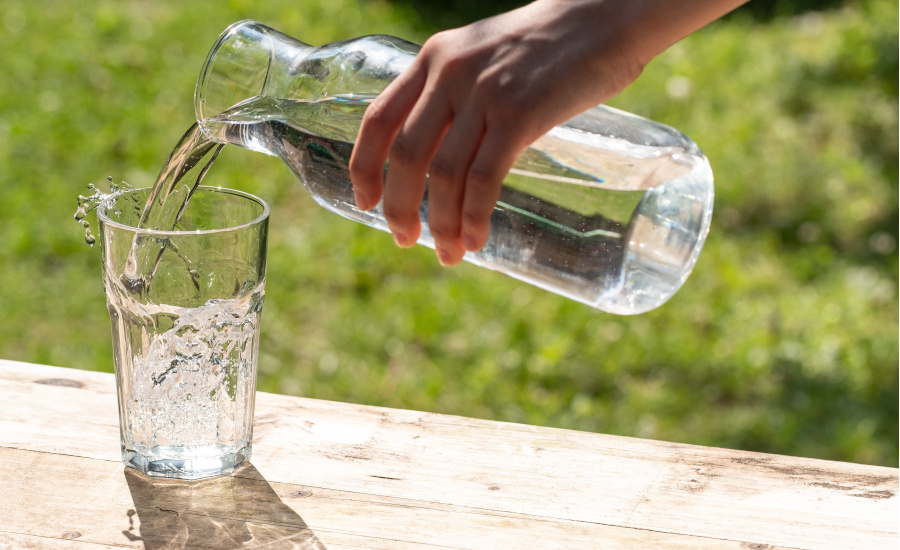Provide your customers with healthy water at home
Help your customers save money rather than purchasing store-bought bottled water.




Today, more than ever, people are concerned with the quality of their drinking water. This is evident when shopping at any grocery, convenience or mass market store because not only do they have a large amount of shelf space dedicated to bottled water, but they also are likely to have a variety of different types of bottled water products to choose from. People often choose these products because they might assume the quality of the water is better than what they get at home.
Is the water your customers are drinking at home healthy and safe?
Focus on drinking water quality
Plumbing professionals might be called to a customer’s home because they have staining in their toilet tank or scale build-up in their shower. Installing an iron filter or water softener might be an easy solution, but these issues could also be a sign of poor drinking water. This is an opportunity to position your business as a helpful ally and expand your services.
Even if a homeowner does not notice any unusual smells or tastes from their drinking water, there may be contaminants present in the water. Things like lead, arsenic, copper, radium, cysts, giardia, cryptosporidium, barium, selenium, chromium, nitrates and many others have no telltale signs and are being consumed through drinking water every day. Over time, these kinds of contaminants can have a negative impact on your customers’ health.
Your customers may assume that if their water comes from the city, it’s safe to drink. While city water treatment plants do produce high quality, EPA-approved water, that same water can travel through many miles of distribution on its way to your customers’ homes. During that time, a variety of microorganisms can enter the water via leeching, leaks and other methods of contamination.
One type of available technology to eliminate any known and emerging contaminants from your customers’ drinking water is a reverse osmosis (RO) system. Other filters, like sediment filters, will remove suspended solids like dirt, debris and sand, and carbon filters will remove organics and can convert chlorine to chloride. However, an RO system reduces the amount of microscopic particles — ions that dissolve into and distribute throughout water that can impact its quality.
The cost and value of reverse osmosis treated water versus bottled water
While your customers might initially think that they can’t afford another piece of water treatment equipment in their home, you can help them understand that an RO system is more cost effective in the long run than purchasing bottled water.
With an RO system, your customers will have healthy, pure drinking water for only pennies per gallon. To calculate savings, find out how much water they drink in their home per week, multiply that amount per year and divide those gallons by the cost of the RO unit. Then, show them the yearly cost of bottled water using an average case price and their average usage amount (the average 24-bottle case of water is just over 3 gallons and costs $3-5). The RO calculation will generally be less in the first year and will keep going down year after year.
Another important benefit of an RO system is the peace of mind your customers will have knowing their water is pure and contaminant-free. That is not necessarily the case with bottled water. People often assume that all bottled water is the same, but, in fact, it isn’t. Bottled water could be city tap water that’s been carbon filtered. It could be mineral water, which must contain no less than 250 parts per million total dissolved solids to be labeled as mineral water. It may also be bottled RO filtered water, which your customer will ultimately pay more for versus having it right on tap in their home. Bottled water is also not free from contamination issues and occasionally has to be recalled by the supplier.
Because water is a universal solvent, over time, it will dissolve whatever it comes into contact with, including the plastic from water bottles. Since there is no way to know how long water has been sitting in bottles, in a hot warehouse, on a delivery truck or in the store where it was purchased, this should be a concern. Customers looking for healthy drinking water can eliminate this variable by having RO treated water at home. Not to mention they are also helping the environment by reducing the use of plastic bottles.
How does reverse osmosis water taste?
Drinking water from an RO system is safer and better tasting. Reverse osmosis also improves the taste of food, coffee and tea when made with RO treated water. RO systems eliminate obvious tastes like chlorine and saltiness, but even customers who don’t notice anything particular ‘off’ about their water often taste a difference compared to their untreated water. With impurities removed, water is crystal clear and transparent, making it a refreshing, thirst quenching option over sugary sodas and juices.
Providing healthy water is good business
When it comes to drinking water, a reverse osmosis system provides pure and healthy water. As a water treatment professional, you can provide the valuable information customers need to make the right decision for their families. Helping them get the best water possible, while saving them money spent on bottled water, builds confidence and trust with you and your company for any future water-related solutions they might need.
Looking for a reprint of this article?
From high-res PDFs to custom plaques, order your copy today!










